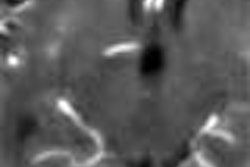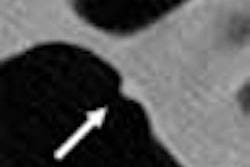There are plenty of indications for percutaneous lung biopsy in children, and at least one team that has been honing the less-invasive procedure for a decade. At the Children's Hospital of Pittsburgh and the Children's Hospital of Philadelphia, Dr. Anne Marie Cahill and colleagues have used core and aspirational biopsy techniques successfully in dozens of patients.
Percutaneous biopsy is first and foremost a diagnostic tool, helping to parse infection and inflammation from tumors, and direct treatment as a result. Occasionally it serves for both diagnosis and surgical biopsy. Performed on an outpatient basis, percutaneous biopsy can result in shorter hospital stays and better diagnoses, while eliminating the need for open surgery most of the time.
"We have reduced post-procedural morbidity and occasional mortality from open procedures," said Dr. Richard Towbin in a presentation at the 2003 Society for Pediatric Radiology meeting in San Francisco.
Towbin, Cahill, and colleagues have performed 74 CT-guided lung biopsies in 62 children since June 1992. The mean age was 10.7 years (range 2 to 20). There were malignancies in a third of patients, post-transplant issues in another third, and then a potpourri of other indications in the rest, Towbin said.
Core biopsies are the method of choice whenever possible; the group has performed them in 58 (78%) of its cases. Other types of biopsies, aspiration procedures and combination procedures, make up the remainder (n=16, 22%). Core biopsies cannot be performed when the lesion is too small, or on rare occasions, when it is too difficult to access, Towbin said.
"For us, if a lesion is less than a centimeter, which is the shortest throw of most core needles, we will not do a core biopsy," and the group relies instead on aspiration, he said.
Any CT imaging method can be used, although contrast media is not used unless the lesion is adjacent to a vascular structure that needs to be isolated. Once the images are reviewed, the best and safest approach route is chosen for the procedure. Overall, sedation was used in favor of general anesthesia in all but 14 cases, Towbin said.
"We use 19 (French) outer, 22 (French) inner gauge needles," Towbin said. "There is an outer and an inner needle so that we protect our tract and reduce our pleural passes to reduce the possibility of pneumothorax...the needle size is the biggest we can possibly fit into the lesion. Bigger is better."
Aspiration often requires multiple passes until liquid can be seen in the needle, while core biopsy is performed in 1 to 3 passes. For sites that present access problems, another technique involves creating a mediastinal window by injecting sterile saline into the extrapleural space. This opens up an access route to the target that avoids penetrating the lung tissue.
Core and aspiration biopsy procedures were performed successfully in 34 unresolved chest x-ray abnormalities, 23 cases of metastatic disease, 10 cases of PLTD/fungal infection, and four cases of granulatomous disease, Towbin said. The mean diameter of lesions in the core biopsy group was 2.5 cm (range 1-10 cm); the mean diameter for the aspiration procedures was 1 cm (range 0.5 to 1.7 cm).
Complications included asymptomatic focal pneumothorax in six cases, asymptomatic perilesional hemorrhage in three cases, and one tension pneumothorax that was treated with a chest tube.
"Generally speaking, you can expect that 10% of your patients will get a pneumothorax, and 10% of those 10% will need treatment," Towbin said. "There were subclinical complications in a larger number, but they were insignificant from a patient-outcome point of view. Our complication rate is low, and is much better than (with) open procedures."
Contraindications include irreversible coagulopathy, inadequate visualization of lesions (which is rare), lack of a safe access route, and procedures in patients with compromised pulmonary function. "And beware...of fungal nodules or vasculidities, because their postprocedural bleeding incidence is higher," Towbin said.
By Eric BarnesAuntMinnie.com staff writer
June 4, 2003
Related Reading
Hopkins docs pursue robotic CT-guided biopsy, April 10, 2002
Copyright © 2003 AuntMinnie.com



















